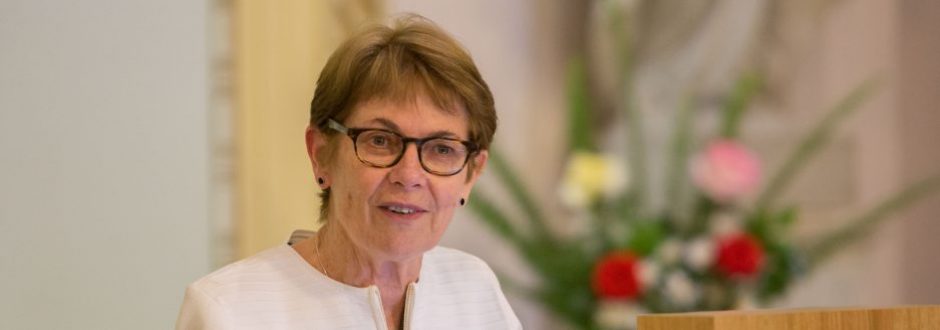In response to the tragedy of institutional child sexual abuse, Sister Patty Fawkner considers the distinct ‘stages’ currently being journeyed through by the Church.
By Patty Fawkner SGS
“It’s just a stage she’s going through”, was my father’s universal explanation for any aberrant behaviour of his six children. As a rebellious teen, Dad’s ’take’ on my misdemeanours made me seethe. Only later when I trained to become a teacher, did I realise the truth of his words.
As trainee teachers we were introduced to ‘stage theory’; that of Jean Piaget’s theory of the Four Stages of Cognitive Development, Erik Erikson’s Stages of Psychosocial Development, James Fowler and Faith Development, Lawrence Kohlberg’s Stages of Moral Development, and of course, the more widely known Elisabeth Kübler-Ross’s Stages of Grief.
It occurs to me that in regard to awareness of, and response to, the tragedy of child sexual abuse within our Church, many of us make a similar journey through distinct stages.
The first stage is Denial and Disbelief. When I was a very young Sister, another community member began supporting a young man who claimed that, as a child, he had been abused by a priest. Naïve and disbelieving, I could not get my head around this situation. I thought, but did not say, “Why are you befriending a trouble-maker?” Blaming the Victim accompanies this stage.
The next stage could be called the Misdiagnosis stage. In the early days of this unfolding crisis within the Church, two key dynamics were at play: we neither understood paedophilia, nor did we understand the impact of sexual abuse on children.
We believed that sexual abuse was a moral problem and did not name it for the pathological crime it was. There would be an allegation, the priest would either deny or show remorse and beg for forgiveness – a forgiveness which was all too easily given. He was given a second chance and moved on where he would abuse again. The devastating pattern was set: forgiveness, move on, abuse; forgiveness, move on, abuse.
Secondly, something blocked us from seeing and hearing the children. There was an appalling lack of duty of care. If children did speak up – and most didn’t – they were not believed. We didn’t understand the lifelong trauma these children would carry and we consistently subordinated their needs to those of the perpetrators.
We only discovered later that the chief concern of Church authorities at that time was managing institutional reputation.
Once more, victims came forward and perpetrators were found to be guilty. I, like so many others, thought it was a case of the proverbial ’few bad apples’. One could call this the Minimising stage.
But slowly, the truth began to emerge, often thanks to the media and police, and Church officials began to play ’catch up’. Perhaps we could call this the Acceptance stage. Collaboratively, Religious Leaders and Bishops developed documents and protocols called Towards Healing, Integrity in Ministry and Integrity in the Service of The Church. Corresponding training programs were introduced. These programs and documents, though not perfect, were and continue to be an honest attempt to be faithful to their intended aim of bringing some healing to victims and survivors, and to enhancing the professional conduct of Church personnel.
For perpetrators, forgiveness gave way to treatment and many were sent to specialised therapeutic programs. However, subsequent recidivism alerted church authorities that still more was needed.
Then came the ‘shock and awe’ of The Royal Commission into Institutional Responses to Child Sexual Abuse. I, with others, was not prepared for the scale of the crisis within the Catholic Church in Australia. In the aftermath of the revelations and public shaming this has become the Game Changing stage.
The Royal Commission was a blessing, enabling thousands upon thousands of people to come forward to tell their story for the first time – and to be believed for the first time. It shone a light into dark places within institutions, particularly within the Catholic Church.
Unequivocally, the Royal Commission said that we are not dealing with the case of a ‘few bad apples’. It critiqued seminary formation, noted the absence of women in leadership roles, and – though not the sole cause – said that clericalism was the single most significant contributing factor to a culture which enabled abuse to go unchecked for decades. Most significantly, it called for structural and cultural change within the Church.
So where are we today?
The Church is now committed to a stage of Creating a Child-Safe Culture which includes risk prevention for vulnerable adults. National Catholic Safeguarding Standards have been developed and every Church agency will be audited and supported to ensure that they comply with these Standards, and are held accountable for the safety of children and vulnerable adults.
Child-safe policies, procedures and training programs for all Church personnel are now the ‘new normal’, but as Sophie Hageman a social work consultant in the area of child protection says, “It is easier to document a culture than to change a culture”.
Not all within the Church are at this stage. Recently I had a conversation with a former teacher about an alleged case of sexual abuse by a priest with whom she had worked decades earlier. The former teacher didn’t know who the claimant was but confidently asserted that they were “just after the money”! As we all come to understand this history of abuse within our Church, my father’s words echo – perhaps “It’s just a stage she’s going through”.
